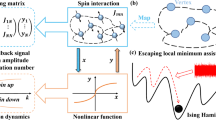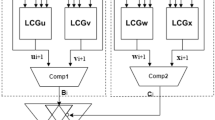Abstract
This paper proposes a new approach to designing a BIST Test Vector Generator (TVG) for random vector-resistant circuits based on reconfigurable Cellular Automata Registers (CARs). Each CAR configuration is constructed by combining rules 90 and 150 and the same approach can also be applied to the Linear Feedback Shift Register (LFSR). The TVG thus designed is able to produce 100% fault coverage with short test time at the cost of low area overhead. To achieve this objective, a new method called the Rank Order Clustering (ROC) method, is introduced in order to fix a number of inputs at certain values when generating pseudorandom vectors. It is shown that the ROC method is very simple and efficient in fixing inputs at these values in terms of complexity. Experimental results have been conducted to demonstrate the applicability of the proposed approach in terms of hardware size and test application time.
Similar content being viewed by others
References
P.H. Bardell, W.H. Mcanney, and J. Savir,Built-In Self-Test for VLSI: Pseudorandom Techniques, John Wiley and Sons, New York, 1987.
W. Pries, A. Thanailakis, and H.C. Card, “Group Properties of Cellular Automata and VLSI Applications,”IEEE Transactions on Computers, Vol. C-35, pp. 1013–1020, December 1986.
P.D. Hortensius, R.D. Mcleod, W. Pries, D. Miller, and H.C. Card, “Cellular Automata-Based Pseudorandom Number Generator for Built-in Self Test,”IEEE Transactions on Computer-Aided Design, Vol. 8, No. 8, pp. 842–858, August 1986.
V.K. Agarwal and E. Cerny, “Store and Generate Built-In Self-Testing,”Proc. FTCS 11, June 1981, pp. 35–40.
J. Van Sas, F. Cattoor, and H. De Man, “Cellular Automata Based Self-Test for Programmable Data Paths,”IEEE International Test Conference, 1990, pp. 769–778.
J. Van Sas, F. Cattoor, and H. De Man, “Optimized BIST Strategies for Programmable Data Paths Based on Cellular Automata,”IEEE International Test Conference, 1992, pp. 110–119.
J. Savir and W.H. McAnneey, “A Multiple Seed Feedback Shift Register,”IEEE International Test Conference, 1990, pp. 657–659.
S. Hellebrand, S. Tarnick, J. Rajski, and B. Courtois, “Generation of Vectors Patterns Through Reseeding of Multiple-Polynomial Linear Feedback Shift Registers,”IEEE International Test Conference, 1992, pp. 120–129.
I. Pomeranz and S.M. Reddy, “3-Weight Pseudo-Random Test Generation Based on a Deterministic Test Set for Combinational and Sequential Circuits,”IEEE Transactions on Computer-Aided Design, Vol. 12, pp. 1050–1058, 1993.
S. Pateras and J. Rajski, “Cube-Contained Random Patterns and Their Application to the Complete Testing of Synthesized Multi-Level Circuits,”IEEE International Test Conference, 1991, pp. 473–482.
M.F. AlShaibi and C.R. Kime, “Fixed-Biased Pseudorandom Built-In Self-Test for Random Pattern Resistant Circuits,”IEEE International Test Conference, 1994, pp. 929–938.
J.R. king and V. Nakornchai, “Machine-Component Group Formation in Group Technology: Review and Extension,”International Journal of Production Research, Vol. 20, pp. 117–133, 1982.
S. Zang, D.M. Miller, and J.C. Muzio, “Determination of Minimal Cost One-Dimensional Linear Cellular Automata,”IEE Electronics Letters, Vol. 27, No. 18, 1991, pp. 1625–1627.
S.Boubezari and B. Kaminska, “Cellular Automata Synthesis Based on Precomputed Test Vectors For-Built-In Self Test,”IEEE International Conference on Computer-Aided Design, Santa Clara, CA, November 1993, pp. 578–583.
F. Brglez and H. Fujiwara, “A Neutral Netlist of 10 Combinational Circuits and a Target Translator in FORTRAN,”IEEE ISCAS, pp. 663–698, June 1988.
F. Brglez, D. Bryan, and K. Kozminski, “Acceerated ATPG and Fault Grading via Testability Analysis,” InDig. Int. Sym. Circuits and Systems, pp. 1929–1934, 1989.
S. Wolfram, “Statistical Mechanics of Cellular Automata,”Rev. Modern Physics, Vol. 55, pp. 601–644, 1983.
S. Wolfram, “Universality and Complexity of Cellular Automata,”Physica, Vol. 10D, pp. 1–35, 1984.
M. Khare and A. Albicki, “Cellular Automata Used for Test Pattern Generation,” InProc. of ICCD'87, 1987, pp. 56–59.
W. Daehn and J. Mucha, “Hardware Test Pattern Generation for nuilt-In Testing,”IEEE International Test Conference, 1981, pp. 110–113.
S.B. Akers and W. Jansz, “Test Embedding in a Built-In Self-Test Environment,”IEEE International Test Conference, 1989, pp. 257–263.
R. Dandapani, J.H. Patel, and J.A. Abraham, “Design of Test Pattern Generator for Built-In Self-Test,”IEEE International Test Conference, 1984, pp. 315–319.
M. Serra, T. Slater, J.C. Muzio, and D.M. Miller, “The Analysis of One Dimensional Cellular Automata and Their Aliasing Properties,”IEEE Transaction on Computer Aided Design of Circuits and Systems, Vol. 9, No 7, pp. 767–778, July 1990.
K.D. Aloke and P.P. Chaudhuri, “Vector Space Theoretic Analysis of Additive Cellular Automata and Its Application for Pseudoexhaustive Test Pattern Generation,”IEEE Transactions On Computers, Vol. 42, No. INSKA, “Cellular Automata Synthesis Based on Precomputed Test Vectors for Built-In Self-Test,”IEEE International Conference on Computer-Aided Design, November 1993, pp. 578–583, Santa Clara, CA.
M. Serra, D.M. Miller, and J.C. Muzio, “Linear Cellular Automata and LFSR's are Isomorphic,”Proceedings of the Third Technical Workshop: New Directions for IC Testing, Hlifax, Nova Scotia, Canada, 1988, pp. 213–223.
B. Ayari and B. Kaminska “BDD_FTEST: Backtrack Test Generator Based on Binary Decision Diagram Representation,” To appear inIEEE Transactions on Computer Aided Design of Circuits and Systems.
I. Pomeranz and S.M. Reddy, “A Learning-Based Method to Match a Test Pattern Generator to a Circuit-Under-Test,”IEEE International Test Conference, 1993, pp. 998–1007.
D.J. Neebel and C.R. Kim “Inhomogeneous Cellular Automata for Weighted Random Pattern Generation,”IEEE International Test Conference, 1993, pp. 1013–1022.
H.K. Lee and D.S. Ha, “An Efficient Forward Fault Simulation Based on the Parallel Pattern Single Fault Propagation,”Proc. of International Test Conference, 1991.
Cadence VISI Design Software.
The CMOS4S Standard Cell Library, as distributed by Canadian Microelectronics Corporation, 1990.
H.K. Lee and D.S. Ha., “Atalanta: An Efficient ATPG for Combinational Circuits,” Technical Report, 93-12, Electronic Testing Group, Dept. of Electrical Eng., Verginia Polytechnic Institute and State University, Blacksburg, Virginia.
A. Kusiak, A. Vannelli, and K.R. Kumar, “Grouping Problem in Scheduling Flexible Manufacturing Systems,”Robotica, Vol. 3, pp. 245–252, 1985.
Author information
Authors and Affiliations
Rights and permissions
About this article
Cite this article
Boubezari, S., Kaminska, B. A new reconfigurable Test Vector Generator for built-in self-test applications. J Electron Test 8, 153–164 (1996). https://doi.org/10.1007/BF02341821
Received:
Revised:
Issue Date:
DOI: https://doi.org/10.1007/BF02341821




